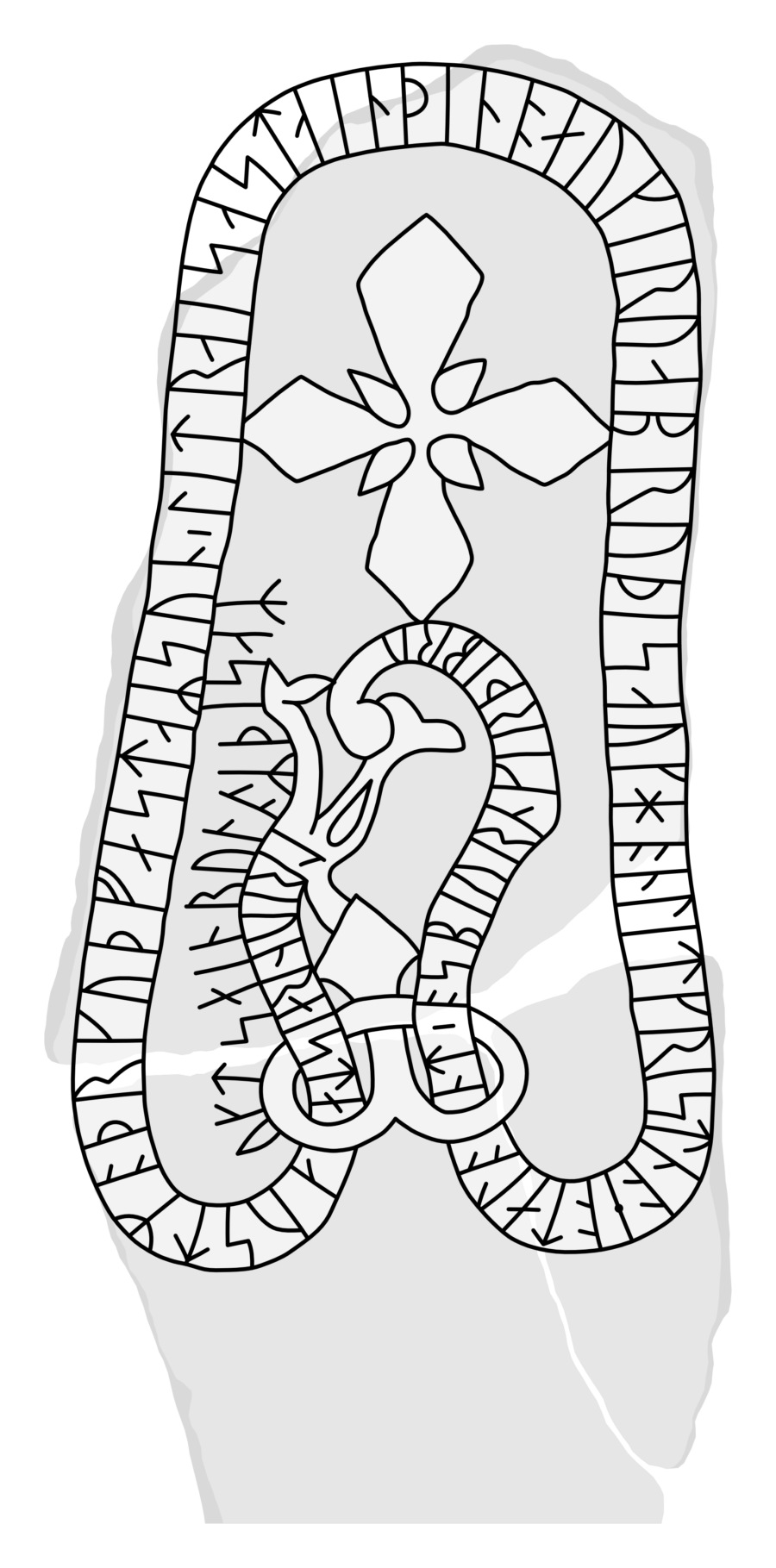
The Frösö Stone J RS1928;66
June 28, 2023
The Jamtamót and the Conversion of Jämtland
The Frösö stone (SE: Frösöstenen) is Jämtland’s only runestone and the northernmost in Sweden.
The stone was raised on the east coast of Frösö (EN: Frey’s island), the largest island in Storsjön (EN: the great lake), around the 1040s.
This area was the central site of the independent territory of Jämtland in the late Viking Age, with its yearly parliamentary assembly, Jamtamót (EN: the gathering of Jamts), taking place on Frösö at Bynäset.
The Jamtamót was similar to the Icelandic Alþing. The parallel is, however, no coincidence as many of the displaced people of the northern regions of Norway who fled the subjugation by King Harald Fairhair (ON: Haraldr hárfagri) in the late 800s took residence in Jämtland instead of colonising Iceland.
The Fröso stone was raised only a few years after the death of the Norwegian King Olaf Haraldson (ON: Óláfr Haraldsson) in 1030 at the Battle of Stiklestad, Trøndelag, just west of Jämtland. He was canonised the following year, and the cult of Saint Olaf became a driving force in the Christianisation of the remaining heathen regions of Scandinavia.
From the inscription on the stone, we learn that Austmaðr, who was most likely the leading magnate or jarl in Jämtland at the time, had commissioned the stone and the nearby bridge across Östersundet, connecting Frösö with the mainland. But most importantly that he was responsible for Christianising Jämtland, though the decision to convert was likely made, as in Iceland, at the Jamtamót. We also learn that Ásbjǫrn built the bridge and that Trjónn and Steinn carved the stone.
The inscription is the earliest documentation of the name Jämtland. And like the Jelling stone in Jylland, Denmark, the Frösö stone is also unique in that it was done in memory of Austmaðr’s Christianization of Jämtland rather than as a cenotaph raised to commemorate a dead relative, which is otherwise by far the most common form of runestones.
Storsjöodjuret
However, the folklore tells a very different story of the origin of the Frösö stone.
According to Jämtland legend, the stone depicts the serpent Storsjöodjuret (EN The Great-Lake Beast), said to live in Storsjön.
The beast was created by two trolls, Jata and Kata, each brewing a cauldron at the shore. Suddenly, with a loud unsettling sound, the creature leapt out of one of the cauldrons and disappeared into the lake.
The black serpent with a cat-like head, now thriving in the lake, became a menace to surrounding areas and grew so big as to encircle the entire island of Frösön and bite its tail.
Then came along Kettil Runske, who bound the beast by carving spells into the runestone erected on the shore of Frösön.
Parts of the beast may still be visible above the water line, but it is warned that it could be set free someday when someone deciphers the runestone.
Another legend has it that during a turbulent time, the stone was torn down and broken in two. As long as the stone lay on the ground, many strange things occurred in the water until the stone was risen and assembled anew.
There have been numerous eyewitness accounts of the serpent since.
The Runestone
The carvings of the stone are in the runestone style Pr 3 (c. 1045-1075) pertaining to the early Urnes style.
The inscription is signed by Trjónn(?) and Steinn.
The granite stone is c. 1,7 m tall, 0,75 m wide and 0,2 m thick. The rune height is 6,5-9 cm.
Runic inscription
The rune text’s first part begins at the animal’s neck right after the crossing of the union-knot loop and continues to the tail end. The second part starts at the head of the animal and breaks onto a new line right before the union-knot loop outside the rune ribbon going in the opposite direction.
Runes
§A ᛆᚢᛋᛏᛉᚭᚦ[(ᚱ)] ᚴᚢᚦᚠᛅᛋᛏᛆᛣ ᛋᚢᚿ ‘ ᛚᛁᛏ ᚱᛆ(ᛁ)[(ᛋ)][ᛆ ᛋᛏᛆᛁ(ᚿ)] (ᚦ)(ᛁ)ᚿᚭ ᛅᚢᚴ| |ᚴᛁᚱᚢᛆ ᛒᚱᚢ ᚦᛁᛋᛆ| |ᛆᚢᚴ ᚼ[ᚭᚿ] [ᛚᛁ](ᛏ) ᚴᚱᛁᛋᛏᚿᚭ ᛂᚭᛏᛅᛚᚭᚿᛏ (ᚭ)ᛋᛒᛁᚢᚱᚿ ᚴᛁᚱᚦᛁ ᛒᚱᚢ §B (ᛏ)ᚱᛁᚢᚿ ᚱᛅᛁᛋᛏ ᛅ¶ᚢᚴ ᛏᛋᛅᛁᚿ ᚱᚢᚿᚭᛣ ᚦᛁᛋᛆᛣ
Transliteration
austmoþ[r]/austmoþ[(r)] kuþfastaʀ sun */’ lit rai…/ra(i)[(s)]… …/…(-)[(n)] þino/(þ)(i)no auk| |kirua bru þisa| |auk h[on] [li]t/[li](t) kristno eotalont/eo(t)alont [*]/ (o)sbiurn kirþi bru triun/(t)riun rai[s]t auk tsain/(t)sain runoʀ þisaʀ
Original Language
Austmaðr, GuðfastaR sunn, let ræi[sa stæin] þenna ok gærva bro þessa ok hann let kristna Iamtaland. Asbiorn gærði bro, Tryn(?)/Trionn ræist ok Stæinn runaR þessaR.
English
Austmaðr, Guðfastr’s son had this stone raised and this bridge made and he had Jamtaland Christianized. Ásbjǫrn made the bridge, Trjónn(?) and Steinn carved these runes.
———
Frösö, Jämtland, Sweden
J RS1928;66